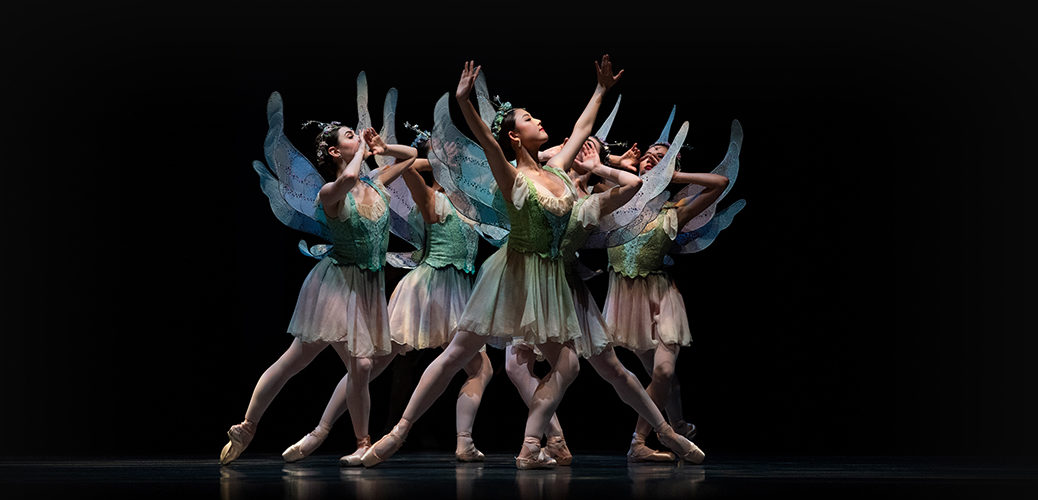
Ballet Blends Balanchine, Shakespeare
For a rare in-depth look at George Balanchine going back to his Russian roots, check out his lavish “Midsummer Night’s Dream” on a stream at the S.F. Ballet. It’s a stunning phalanx of 50 or more perfectly attuned dancers, a spectacle of palatial elegance and dance perfection. If only it had similar sparkle or propulsion.
We regard Balanchine as a great, one of the fathers of modern ballet. In this 1962 “Dream” however he reverted to the spirit of 19th-century Petipa days back in St. Petersburg, executed beautifully, as if you were coming upon a room full of rare china and crystal chandeliers. At first glance it’s a show to take the kids to, as much as “Nutcracker.” But the humor and whimsey are in short supply, even with that cutup Puck cavorting about the stage doing his boyish magical mischief. The convoluted madness of the Shakespearean plot is crammed into the first half, where a large cast plays out the fantasy of mismatched lovers, the result of a magical flower radically reorienting every one’s love interest in zany ways.
Only a true Shakespearean can tell apart the soloistic ladies—Hermia, Helena, Hyppolyta, Titania—or tell which truly belongs paired off with Lysander, Theseus, Oberon or Demetrius. The philandering Puck can scramble the lineup of lovers with glee until finally the bumpkin Bottom is turned into a donkey, sought after as the ludicrous ardent love object of the spellbound, queenly Titania.
Both Balanchine and Sir Frederick Ashton did ballet versions of Shakespeare’s “Dream” the 1960s to grace each side of the Atlantic. Both use as foundation stone Mendelssohn’s score embodying some of the most deft tone-painting of any German-romantic music. The biggest difference lay in the role of the donkey—- in Ashton, farcically pawing a hoof on the ground to accompany the asinine “bray” in the priceless score, while in Balanchine playing a dignified, gentleman-like role with halting steps—-at least, as dignified as that giant donkey’s head would permit. In addition, Ashton created a one-acter, while Balanchine made it evening-length, adding snippets of other Mendelssohn as needed, particularly for the grand but soulless ballet spectacle in breath-taking glittering costumes that makes up the old-line act-two divertissements.
Curiously enough, for the balletomane the high point comes in the lengthy and highly demanding act two pas de deux, done here by Frances Chung with Ulrik Birkkjaer. Each time you think they will wilt in this nonstop seven-minute duo, they come back with yet more arabesques and lifts with an Olympian energy. It is a breath-taking tour de force that, in streaming, you might want to view over and over.
The take-away here is the near-infinite depth of the SFB, even in a casting devoid of some of the top company stars. It’s as if the troupe defies you to find any weakness is the endless lead parts. That, whether Sasha De Sola (Titania), Elizabeth Powell (Hermia) or Sarah Van Patten (Helena), or alternatively Luke Ingham (Demetrius), Esteban Hernandez (Oberon), Myles Thatcher (Lysander), Tiit Helimets (Theseus) or that endearing man-donkey Bottom played by Lucas Erni. The spell-caster Puck was Cavan Conley, more mischief than merriment. The national backgrounds of these were most diverse: Mexico, Argentina, Estonia, Canada, Denmark, Australia, USA.
Of note in a tour-de-force role leading the hunters was the athletic Sasha Mukhamedov playing Hyppolyta——part Amazon, part archer. Uniquely at the end she could take her bow while carting her bow.
Martin West led the pit orchestra, to which my measly laptop speakers cannot do justice.
S.F. Ballet in Balanchine’s 1962 “Midsummer Night’s Dream,” filmed at the Opera House, S.F. March, 2020, now streaming. This and other streams available by subscription online via www.sfballet.org or call (415) 865-2000.